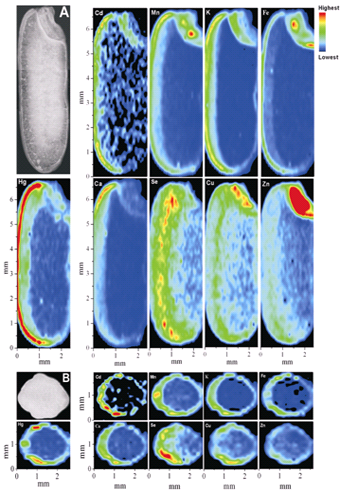| Localization and speciation of mercury in brown rice |
| From: PublishDate:2015-06-16 Hits: |
Cultivation of paddy rice for human consumption is a dominant agricultural activity throughout Asia. High levels of mercury (Hg) in rice grain pose a potential threat to human health, although the extent of risk is dependent on the chemical speciation of Hg inside the grain. The chemical speciation of Hg defines the bioavailablity and toxicity of this element in biological samples. The complexation of Hg with bio-molecules (including complexation to hydrosulfide or thiol ligands), therefore, plays a key role in the mechanism of distribution, transport, and accumulation of Hg in biota. Previous studies do not afford comprehensive understanding of the speciation and localisation of Hg throughout rice grain. Such understanding is critical in defining a better model for human risk that may be associated with the ingestion of MeHg-contaminated rice. The research group from Institute of Geochemistry, Chinese Academy of Sciences reported speciation and localization of Hg in three fractions of rice grain (hull, bran, and white rice), which is recently published in Environmental Science & Technology (2014, 48, 7974-7981). On a mass basis, the majority of inorganic mercury (IHg) in a rice grain is found in hull and bran. However, the majority of the more toxic species MeHg is found in edible white rice. During grain processing, most of the IHg (~78%) is eliminated, but the majority of the MeHg remains in the food product (~80%). Synchrotron radiation microscopic X-ray fluorescence (SR-μXRF) mapping reveals strong localization of Hg at the surface of brown rice grains, corresponding to the pericarp and aleurone layer (Figure 1). Based on X-ray absorption near-edge spectroscopy (XANES) data, the researchers proposed that IHg in bran is primarily bound to cysteine, and is associated with phytochelatins (Figure 2). Consequently, IHg is largely immobile and restricted to the outer layers of rice grain. MeHg in bran is primarily bound to cysteine and is associated with proteins. However, this MeHg-cysteine association behaves like a mobile nutrient and is actively transported to the endosperm during seed ripening. Concentration of MeHg-cysteine in white rice has implications for public health. There is growing evidence for Hg contamination of rice throughout Asia due to point and diffuse sources of Hg pollution. The magnitude of the associated risk must be quantified through better understanding of the localization and speciation of mercury in rice. This work makes an effort to contribute to this understanding.
Figure 1. Elemental maps of longitudinal (A) and latitudinal (B) sections of rice grain (ventral side on right). The SR-μXRF signals for map (A) and (B) were collected at 50 μm and 100 μm steps, respectively. The areas mapped for (A) and (B) were 6800 μm x 2400 μm and 2600 μm x 1900 μm, respectively. |
|
|
| Chinese
- Beamline 1W1 of BSRF started to runoperate in the couplingparasitic mode of BEPCII
- Synthesis of High Performance Polymer Materials for Field Effect-Transistors
- Surfactant molecular aggregates in green solvents
- GIXRD has played an important role in the characterization of organic thin-film transistors
Copyright © 2011 - 2012 Beijing Synchrotron Radiation Facility


